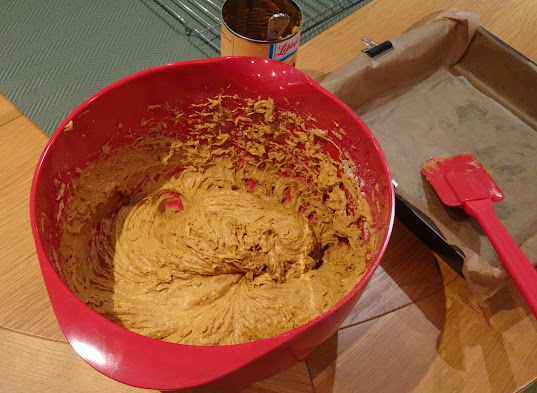I was unsure whether to post about this cake or not - because I was in two minds about it.
I spotted the recipe in a lovely blog called "the English kitchen" by Marie Rayner and just had to try it. It's called "two ingredient pumpkin cake" and my first reaction was "never!".
Apparently the recipe was turning up all over the internet a few years ago and the two ingredients are just a Dr Oetker carrot cake mix and a tin of pumpkin purée. (I don't use a cake mix very often but have noticed that they appear frequently in recipes from the other side of the Atlantic.)
I rummaged in my cupboard and dug out the last tin of pumpkin purée from my stash saved for my usual pumpkin spice cake or a pumpkin pie. (See here and here.) I picked up a carrot cake mix on my next supermarket shop and on glancing at the instructions was puzzled. If you are supposed to add eggs, oil and water to the carrot cake mix, how could it work with just a tin of pumpkin purée instead? I even left a comment on Marie's blog to check and she came back to say yes, that's all you do!
Well it did work after a fashion! The mixture was very stiff and it didn't rise much in the tin. The cake itself was a fabulous colour, lovely and moist with a nice even crumb and a rich, spicy flavour. However…..each mouthful kind of dissolved into something very…..it’s hard to find the right word…..gluey in the mouth. Very odd. I'm not sure I would make it again - unless I was very pressed for time as it certainly was a rapid bake and very tasty. No measuring out and the longest process required was lining the tin!
As it happened I didn’t get around to icing it with the cider glaze. I hadn't any cider in the house and had planned to use apple and mango juice instead, but visitors arrived just as I was taking it out of the oven. Their opinion on the cake was "the ginger saved it!" You can see the original recipe here. I would be interested to hear how you got on if you decide to try it!
It did occur to me that it was the ideal cake for Hallowe'en! Very quick to make, would take all the spooky decorations you could throw at it and that odd texture in the mouth has a decidedly uncanny feel to it!
Ingredients
A 425g tin of pumpkin purée. I have seen this for sale in Waitrose on the tinned fruit and veg shelf, also in Tesco with the jams and spreads. Otherwise you can get it online via Waitrose, Ocado or Amazon.
A box of Dr Oetker carrot cake mix.
For the glaze
140g icing sugar, mixed with a pinch of mixed spice and enough cider or apple juice to make it drizzlable.
Method
Preheat the oven to 180°C / 160° fan. Butter and line a 22cm square cake tin.
Beat the ingredients together using an electric whisk until well combined. This will take at least two minutes! Spoon into the tin and level the top.
Bake for 25-30 minutes until done. Cool in the tin for ten minutes before turning out onto a wire rack. Cool completely before drizzling the icing over.
Cuts into 12-16 squares.




















